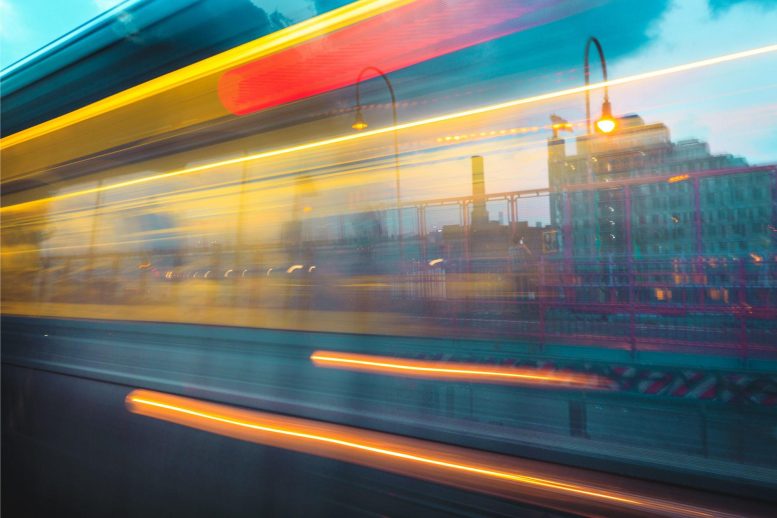
According to the research, crowded train rides felt like they took about 10% longer than the least crowded ones.
An interdisciplinary team of researchers from Cornell University conducted a study on time perception in a highly realistic setting, using virtual reality simulations of a New York City subway train.
They discovered that crowding in the virtual train made time appear to pass at a slower rate, which may result in rush-hour commutes on public transit feeling longer than rides that take the same amount of time objectively.
The research adds to evidence that social context and subjective feelings distort our sense of the passage of time, and may have practical implications for people’s willingness to use public transit, particularly after the pandemic.
“It’s a new way of thinking about social crowding, showing that it changes how we perceive time,” said Saeedeh Sadeghi, M.S. ’19, a doctoral student in the field of psychology. “Crowding creates stressful feelings, and that makes a trip feel longer.”
Sadeghi is the lead author of a recent study published in the journal Virtual Reality. Co-authors are Ricardo Daziano, associate professor of civil and environmental engineering in the College of Engineering; So-Yeon Yoon, associate professor in the Department of Human Centered Design in the College of Human Ecology (CHE); and Adam K. Anderson, professor in the Department of Psychology and in CHE.
Prior research has identified subjective emotions, heart rate, and a situation’s complexity, including the number of items requiring attention, among factors that can influence one’s experience of time. Experiments typically have been conducted in lab settings using simple tasks and stimuli, such as shapes or images on a computer screen, for short durations.
In a novel application of VR, the Cornell team tested time perception in an immersive environment that was far more realistic, but that allowed crowding to be systematically controlled. More than 40 study participants took five simulated subway trips with a randomly assigned duration of 60, 70, or 80 seconds, each with varying crowding levels.
After donning heart-rate monitors and VR goggles to “board” the New York City subway scene developed by Yoon, participants heard an announcement to “stand clear of the closing doors, please,” followed by the ding-dong of a bell as doors closed and the sound of a subway accelerating. The trip ended with the train stopping and another bell sound.
Each crowding level added one person per square meter, resulting in crowds ranging from 35 to 175 passengers. Study participants could look around the train car at animated avatars of seated and standing passengers who changed positions, looked at phones, or read books and magazines.
After each trip, study participants answered questions about how pleasant or unpleasant the experience was on a scale from 1 to 7, and were asked to do their best to accurately estimate how long the trip took.
The result: Crowded trips on average felt like they took about 10% longer than the least crowded rides. The distortion of time-related to the degree of pleasure or displeasure experienced, with unpleasant trips feeling 20% longer than pleasant ones, which the authors attributed to the activation of emotional defense systems when people feel their personal space is violated.
“This study highlights how our everyday experience of people, and our subjective emotions about them, dramatically warps our sense of time,” Anderson said. “Time is more than what the clock says; it is how we feel or value it as a resource.”
Based on U.S. transit commutes averaging just over 60 minutes per day, the results imply that a year of crowded commuting would add more than 24 hours, or three full workdays, of “felt” time to reach destinations.
Crowding’s influence on perceived travel time likely will only grow stronger after coronavirus-related warnings to avoid crowds, according to the research. That could contribute to more people choosing alternatives to public transit, potentially increasing commuting’s carbon footprint.
In addition to their basic science finding about the nature of time perception, the scholars said their research could help transportation engineers improve ridership models – the focus of a related research paper – and vehicle designs. Mitigating the unpleasant experience of crowding, they said, would make trips feel shorter.
Reference: “Affective experience in a virtual crowd regulates perceived travel time” by Saeedeh Sadeghi, Ricardo Daziano, So-Yeon Yoon and Adam K. Anderson, 3 November 2022, Virtual Reality.
DOI: 10.1007/s10055-022-00713-8
The study was funded by the Cornell Center for Social Sciences, the Center for Transportation, Environment and Community Health, and the National Science Foundation.









Most likely, the observed anomalies result from underestimated uncertainties in the core data from the radioactive decays used for the flux prediction, and not from the neutrino experiments themselves.”Most likely, the observed anomalies result from underestimated uncertainties in the core data from the radioactive decays used for the flux prediction, and not from the neutrino experiments themselves.”
Isaiah James Knight this is very Similar to the Miscalculation Made with Ramen Serial numbers 762 interaction with livorium is actually relatively , “Mediocre”. Only noticed after there was a Major Error in Observation data
ISAIAH JAMES KNIGHT
شكرا